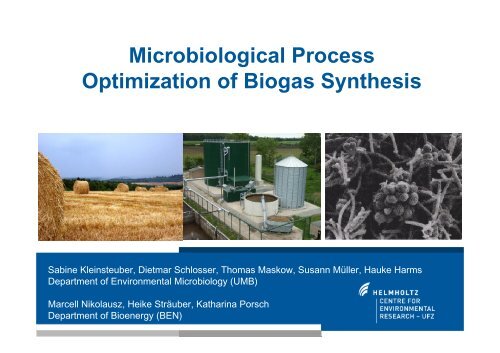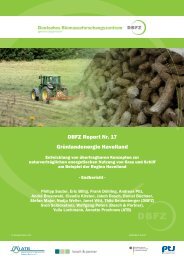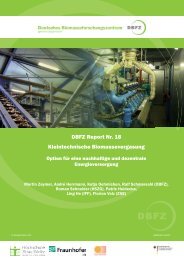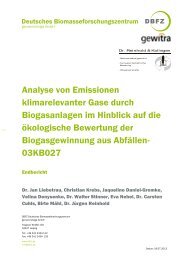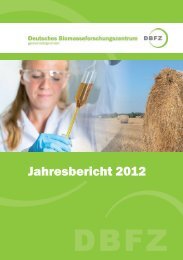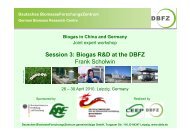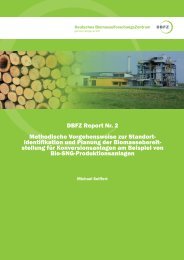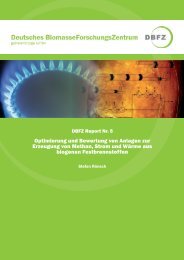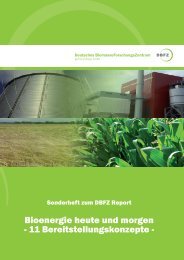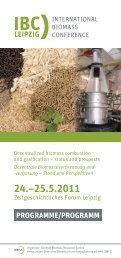Microbiological Process Optimization of Biogas Synthesis
Microbiological Process Optimization of Biogas Synthesis
Microbiological Process Optimization of Biogas Synthesis
You also want an ePaper? Increase the reach of your titles
YUMPU automatically turns print PDFs into web optimized ePapers that Google loves.
<strong>Microbiological</strong> <strong>Process</strong><br />
<strong>Optimization</strong> <strong>of</strong> <strong>Biogas</strong> <strong>Synthesis</strong><br />
Sabine Kleinsteuber, Dietmar Schlosser, Thomas Maskow, Susann Müller, Hauke Harms<br />
Department <strong>of</strong> Environmental Microbiology (UMB)<br />
Marcell Nikolausz, Heike Sträuber, Katharina Porsch<br />
Department <strong>of</strong> Bioenergy (BEN)
Helmholtz Research Field “Energy“<br />
Research Program “Renewable Energies“<br />
Topic: Refining Biomass into Chemical<br />
Energy<br />
Subtopic: Methane from Biochemical <strong>Process</strong>es<br />
Involved UFZ departments:<br />
Bioenergy (BEN), Environmental Microbiology (UMB),<br />
Environmental Engineering (TUCHEM), Centre for<br />
Environmental Biotechnology (UBZ)<br />
Collaboration partner: German Biomass<br />
Research Center (DBFZ), Dept. <strong>Biogas</strong><br />
Technology
Methane from Biochemical <strong>Process</strong>es<br />
Challenges<br />
• More than 4700 biogas plants are<br />
operated in Germany (2.9% <strong>of</strong> gross<br />
power generation)<br />
• <strong>Process</strong> optimization potential for<br />
existing plants = 20-50%<br />
• Much higher biogas potential <strong>of</strong> still<br />
untapped substrates<br />
• Solutions for fermentation residues<br />
<strong>of</strong> biogas production<br />
<strong>Biogas</strong> plants in Germany
Objectives<br />
Improvement <strong>of</strong> efficiency and process stability <strong>of</strong><br />
biomethane synthesis<br />
� Microbial indicators for process stability and dysfunction<br />
� Diagnostic tools for process control<br />
� Improve methane yield by process optimization and re-use <strong>of</strong><br />
digestates<br />
Exploitation <strong>of</strong> novel feedstocks<br />
� Agricultural, industrial and municipal waste<br />
� In particular: lignocellulosic residues, re-use <strong>of</strong> digestates from<br />
biogas processes (currently only used as fertilizer) and<br />
residues from bi<strong>of</strong>uel production<br />
� Learn from natural microbial processes: wood-decaying fungi,<br />
gut microbiota <strong>of</strong> xylophagous arthropods and mammals
3<br />
2<br />
2<br />
1<br />
1<br />
2<br />
4<br />
Microbiology <strong>of</strong> the<br />
biogas process:<br />
A Black Box?<br />
Functional groups:<br />
1: Primary fermenters<br />
2: Secondary fermenters<br />
(syntrophic consortia),<br />
homoacetogens<br />
3: Aceticlastic methanogens<br />
4: Hydrogenotrophic<br />
methanogens<br />
Competing: sulfate reducers
Specific research questions<br />
� Rate-limiting steps under different process conditions and depending<br />
on the feedstock<br />
� Key organisms <strong>of</strong> hydrolysis/acidogenesis (depending on feedstock)<br />
� Improving efficiency <strong>of</strong> hydrolysis by inoculation<br />
� Recovery <strong>of</strong> methanogenesis by pre-adapted consortia<br />
� Aceticlastic vs. hydrogenotrophic methanogenesis – which one<br />
performs better under which conditions (and which groups <strong>of</strong> archaea)<br />
� Key organisms <strong>of</strong> acetogenesis, role <strong>of</strong> homoacetogens<br />
� Competition for hydrogen and organic substrates (e.g. by SRB)<br />
� Stability under high ammonia load, low pH, high VFA, high organic<br />
load, short retention times …<br />
� <strong>Optimization</strong> <strong>of</strong> trace element supply (additives vs. substrate mixture<br />
optimization)<br />
� Constant vs. fluctuating process conditions: diversity – resilience –<br />
process stability<br />
� Single stage vs. two stage processes<br />
� Mesophilic vs. thermophilic processes<br />
� ….
Extending the utilization <strong>of</strong> lignocellulosic feedstocks for<br />
biochemical conversion into bioenergy<br />
Lignocellulosic materials not readily<br />
applicable in fermentation for<br />
biogas production<br />
Cellulose<br />
micr<strong>of</strong>ibrils<br />
Cellulose<br />
Hemicelluloses<br />
γ<br />
β<br />
α<br />
Lignin<br />
Pre-treatment with lignocellulose-decaying<br />
microorganisms / enzymes derived there<strong>of</strong><br />
• fungi with specific natural adaptations & capabilities<br />
• cellulases, hemicellulases, lignin-modifying enzymes<br />
Aquatic<br />
hyphomycetes<br />
as a still<br />
untapped<br />
bioresource<br />
Improved availability <strong>of</strong> lignocellulosic residues
Two-stage reactor system:<br />
Metabolite and energy flow<br />
substrate<br />
substrate<br />
pump 1<br />
Temp<br />
Control 1<br />
Gas<br />
analysis 1<br />
Efflux 1<br />
Reactor 1<br />
Hydrolysis and<br />
Acidogenesis<br />
pH‐<br />
controlled<br />
substrate<br />
pump<br />
Temp<br />
Control 2<br />
Gas<br />
analysis 2<br />
Reactor 2<br />
Efflux 2<br />
Acetogenesis and<br />
Methanogenesis
Methods to study metabolite<br />
and energy flow:<br />
Calorimetry<br />
� Non-invasive<br />
� Real-time measure <strong>of</strong> metabolic activity<br />
� Real-time indication <strong>of</strong> metabolic changes<br />
Aceticlastic vs. hydrogenotrophic methanogenesis<br />
CH 3COOH � CO 2 + CH 4<br />
endothermic reaction<br />
4 H 2 + CO 2 � CH 4 + 2 H 2O extremely exothermic reaction<br />
� Ratio between both reactions under different conditions<br />
� Ratio between methanogenesis and competing reactions (e.g.<br />
sulfate reduction)<br />
� Influence <strong>of</strong> hydrogen partial pressure<br />
Combination with metabolomics / modeling
Methods to study metabolite and energy flow:<br />
Isotope signature analysis and isotope tracers<br />
Whiticar (1999)<br />
� Determine<br />
proportions <strong>of</strong><br />
aceticlastic and<br />
hydrogenotrophic<br />
methanogenesis<br />
� Metabolite<br />
analysis by isotope<br />
tracers<br />
� Combination with<br />
molecular methods<br />
� Data for modeling
Müller & Nebe-von-Caron (2010)<br />
FEMS Microbiol. Rev.<br />
Flow Cytometry<br />
� Studying community<br />
dynamics<br />
� High resolution analysis<br />
<strong>of</strong> key sub-communities<br />
based on single cell<br />
characteristics (e.g. cellular<br />
DNA content, scatter<br />
behaviour)<br />
� Combination with<br />
molecular methods and<br />
statistical pattern analysis<br />
� Data for modeling
Müller et al. (2010)<br />
Fluorescence<br />
Assisted Cell<br />
Sorting (FACS)<br />
Unravel complex microbial<br />
communities using<br />
multiparametric flow cytometry<br />
Phylogenetic and functional<br />
pr<strong>of</strong>iling <strong>of</strong> sub-communities<br />
� Genomics<br />
� Transcriptomics<br />
� Proteomics<br />
� Isolation and cultivation
Molecular approaches for community analysis<br />
Phylogenetic<br />
identification<br />
In situ detection and<br />
quantification<br />
PCR<br />
Bacterial<br />
and<br />
archaeal<br />
groups<br />
Community<br />
pr<strong>of</strong>iling<br />
100%<br />
Functional<br />
diversity<br />
50%<br />
0%<br />
mcrA<br />
fhs<br />
Zz 5-7 Zz 53-56 Zz 9-00
T-RFLP pr<strong>of</strong>iles <strong>of</strong> the methanogenic community in DDGS-fed digesters<br />
Methanoculleus<br />
Gas production: 4.46 L/d<br />
4462 ppm H 2 S<br />
Gas production: 5.85 L/d<br />
281 ppm H 2 S (FeCl 3 )<br />
Propionic acid: 0 mg/L<br />
Gas production: 5.68 L/d<br />
47 ppm H 2 S (FeCl 3 )<br />
Propionic acid: 0 mg/L<br />
Gas production: 5.97 L/d<br />
69 ppm H 2 S (FeCl 3 )<br />
Propionic acid: 0 mg/L<br />
Propionic acid: 64.3 mg/L<br />
Gas production: 13.88 L/d<br />
31 ppm H 2 S (Ferrosorp)<br />
Propionic acid: 0 mg/L<br />
Methanosarcinales<br />
Methanosaeta<br />
Methanosarcina<br />
Methanomicrobiales<br />
#6.2<br />
#6.3<br />
#6.4<br />
#6.5<br />
#6.6<br />
Ziganshin et al., in prep.
Improved molecular strategies to assess<br />
community activity and dynamics<br />
� RNA is a more sensitive marker <strong>of</strong> activity changes<br />
compared to DNA<br />
� Functional gene approach provides information on<br />
the structure <strong>of</strong> certain functional guilds<br />
�Methanogens – mcrA (Methyl coenzym M reductase)<br />
�Acetogens – fhs (Formyltetrahydr<strong>of</strong>olate synthetase)<br />
�Sulfate reduction – dsrAB (Dissimilatory sulfite reductase)<br />
� Cellulase and hydrogenase genes<br />
� …<br />
�Strategy: Study expression <strong>of</strong> functional genes<br />
Combination with flow cytometry, isotope tools,<br />
metabolomics, modeling
Analysis <strong>of</strong> syntrophic consortia by fluorescence-based methods:<br />
CARD-FISH, Magneto-FISH, CLSM<br />
©2008 by National Academy <strong>of</strong> Sciences<br />
Pernthaler et al. (2008) PNAS 105:7052-7057
Functional Description <strong>of</strong> <strong>Biogas</strong> Communities<br />
Epi-metabolome and thermodynamic analysis Community dynamics and interactions<br />
Metabolic network modeling Disturbance regimes – process optimization
Thank you for your attention!


